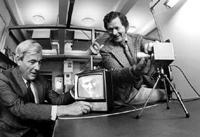The optical fibers and eyes of digital cameras, protagonists of the Physics Novel
This year's Nobel Prize in Physics has been for two different discoveries. Half Prize Charles K. He will be received by Kao for his research in light transmission through fiber optics. And the other half Willard S. Boyle and George E. Smith will be aimed at researchers by discovering a digital CCD image sensor, an electronic eye of digital cameras.
In the world there is a billion kilometers of fiber optic. These fibers transport images, texts, videos, audios and many data at high speed through light. Optical fibers make up much of today's communications networks.

The invention of the laser in the early 1960s was an important step in the development of optical fibers, as it allowed encoding information through light. But the transportation of that light was something else. There were optical fibers, but with those of that time only 1% of the light remained every 20 meters.
In fact, Charles Kuen Kao was investigating how to improve this problem with a clear objective: that at least 1% of the light introduced into the fiber reaches one kilometre. In 1966 he presented the result of his research: the key to the manufacture of fibres with the purest glass possible.
A few years later, researchers at the American glass factory Corning Glass Works managed to manufacture ultra-fine fibres of high purity. It may seem that ultra-thin glass fibres are very fragile, but their properties are different in fibres: they are hard, light and flexible. It is therefore an excellent material for use as a communication thread.
In the current optical fibers reaches a kilometer 95% of the light. And the capacity of the fibers is increasing.
Electronic eye
The development of digital cameras is not inferior to optical fibers. And the CCD (Charged Coupled Device) sensor devised by researchers Willard Boyle and George Smith has been instrumental in this development. Because the CCD is the eye of digital cameras.

Willard Boyle and George Smith with CCD. Ed. :
Alcatel-Lucent/Bell Labs
Boyle and Smith didn't have the digital photos on their heads when they developed the CCD, they wanted to create better electronic memory. Currently this use is not given to the CCD, but it cannot be said that the discovery has not been successful.
The CCD is a silicone plate filled with photosensitive cells. By hitting the light that enters through the target on this plate, the CCD transforms the light intensity that each cell receives into an electric charge. There is an electric change that can become a binary number, i.e. digitized. In this way, each cell takes the information from a point of the image and with it you can form a pixel of the digital photo.
Thanks to the CCD, a new era began for photography and, in general, for the image. And this has also had a great influence in different areas of science. The Hubble telescope, for example, is the technology that allows to extract these spectacular images of the universe.
Buletina
Bidali zure helbide elektronikoa eta jaso asteroko buletina zure sarrera-ontzian











